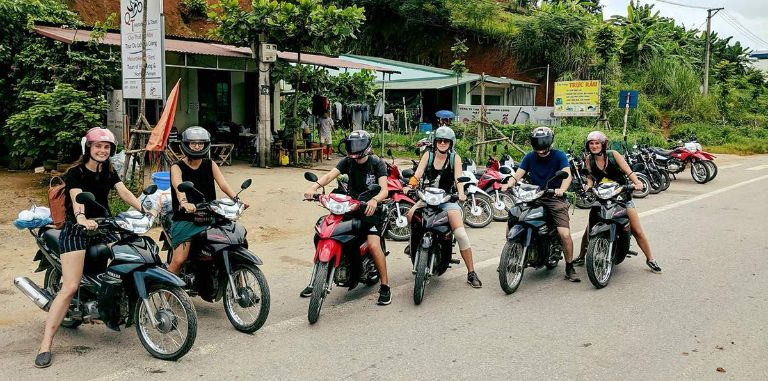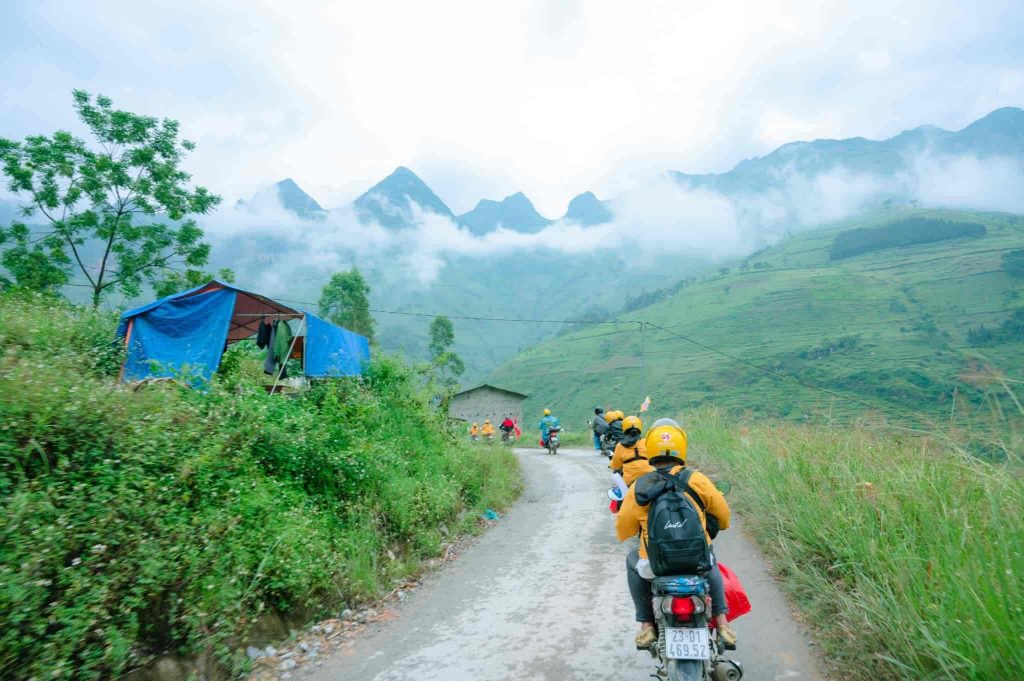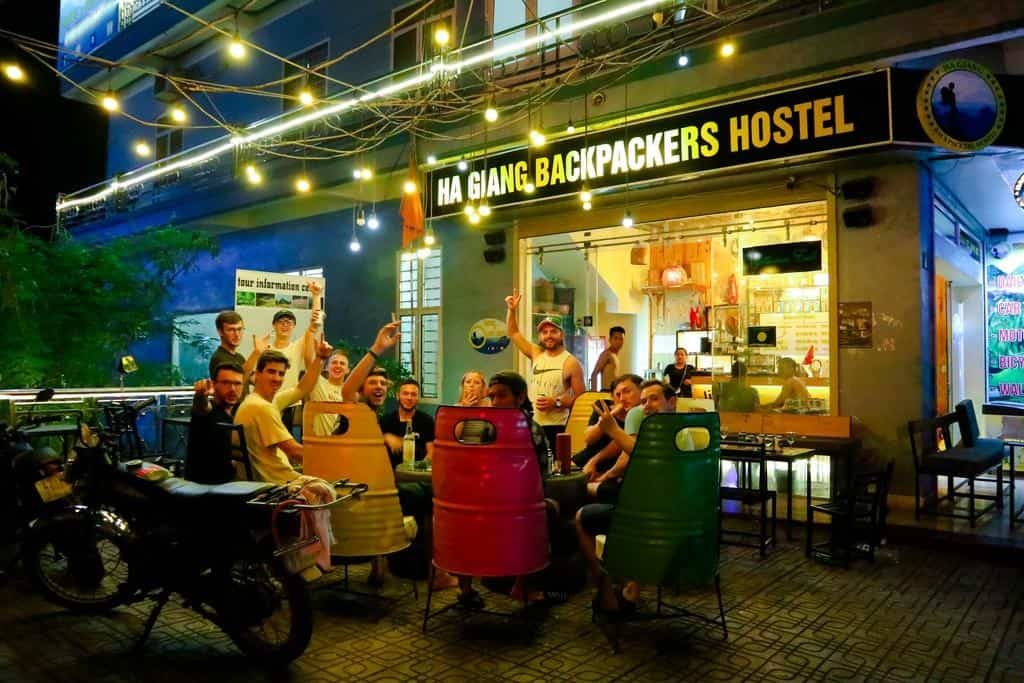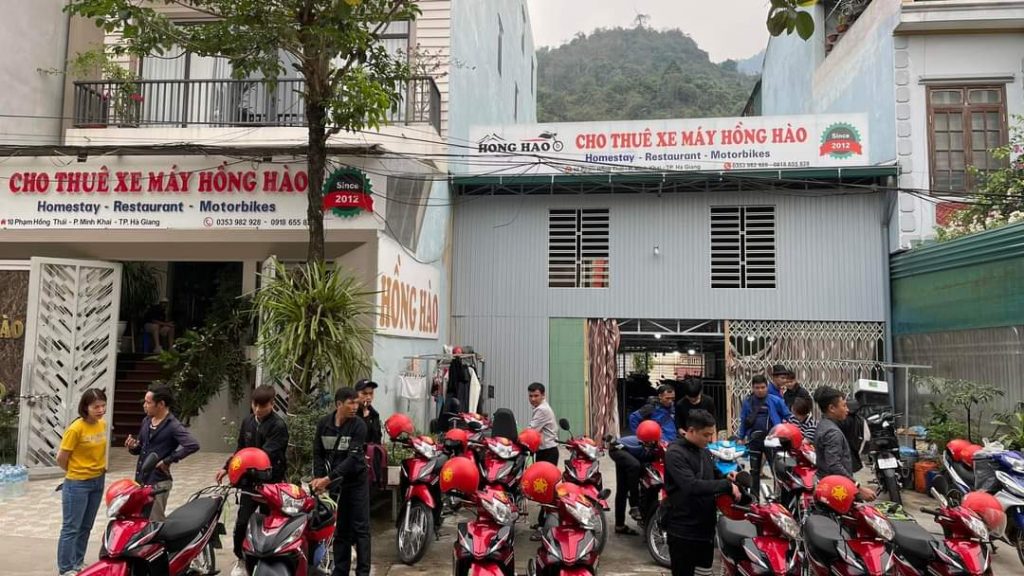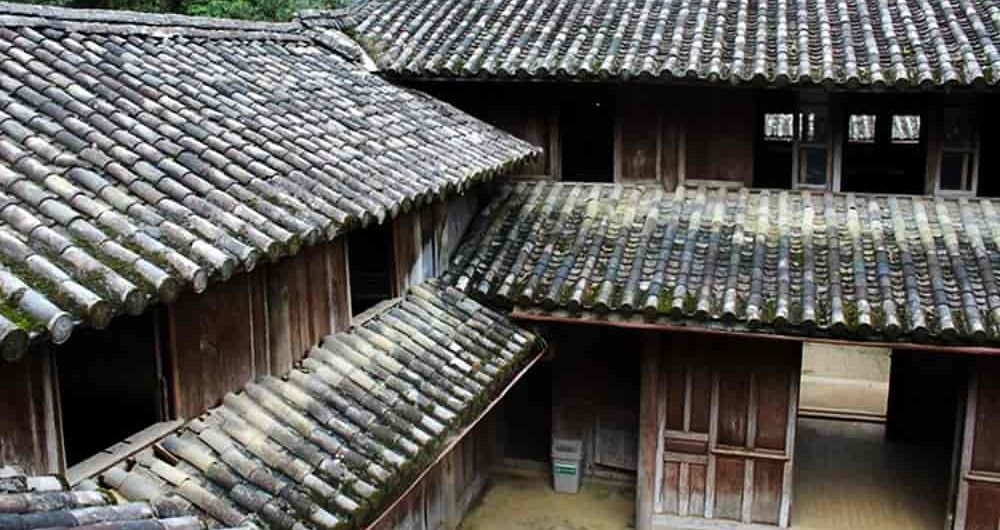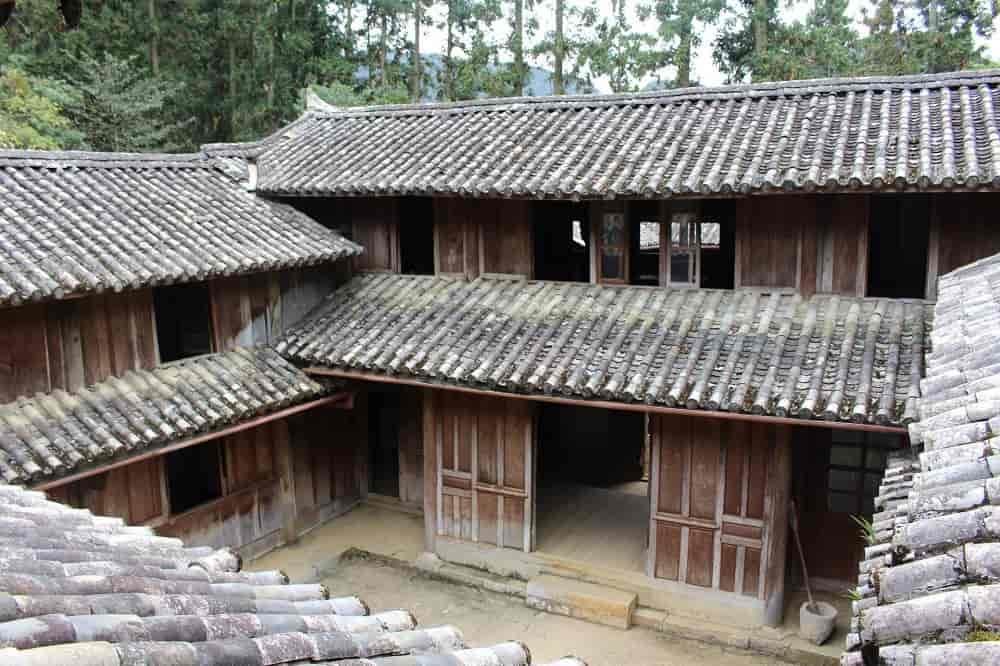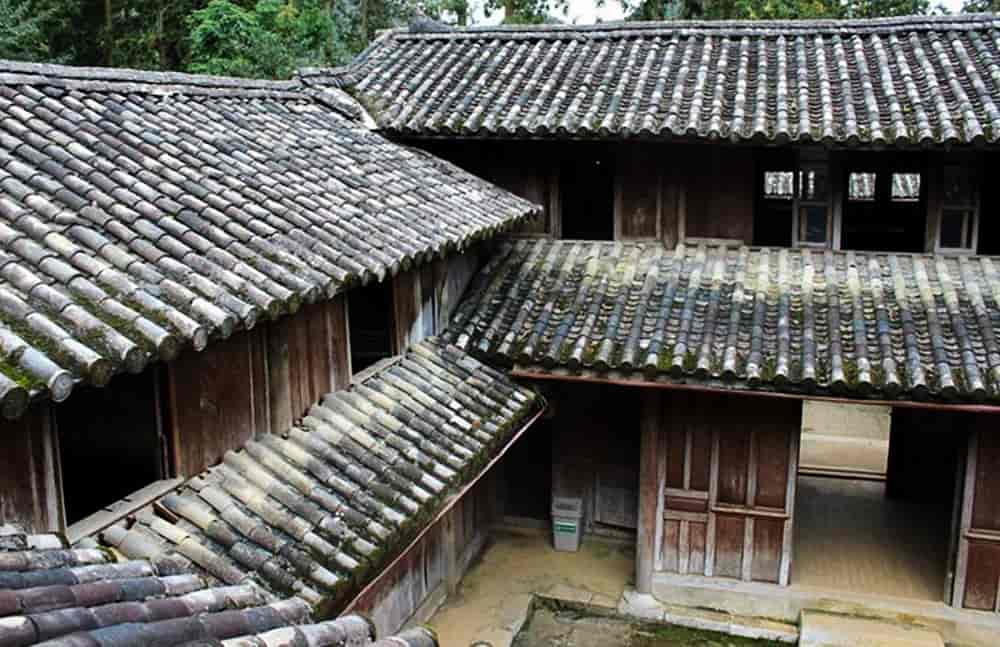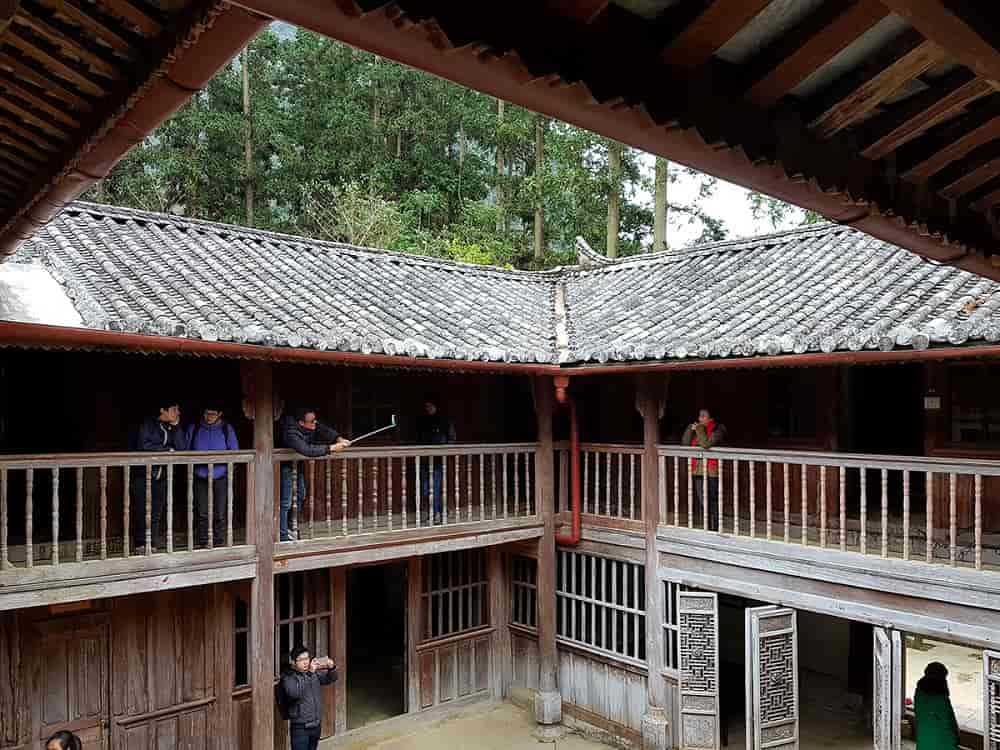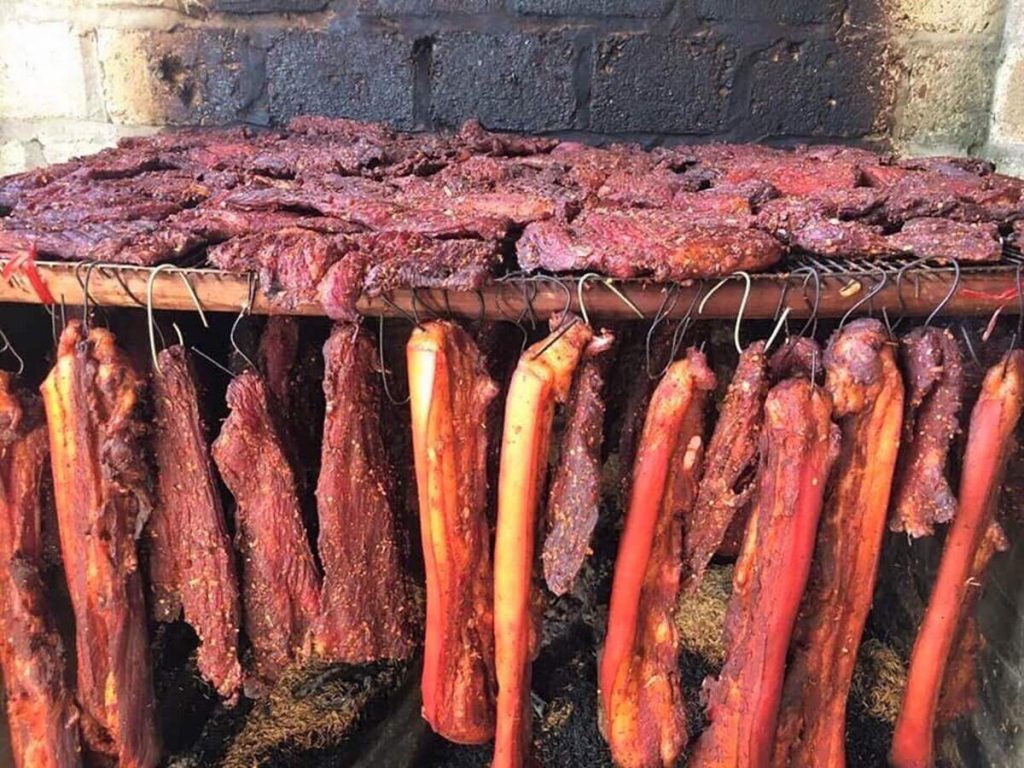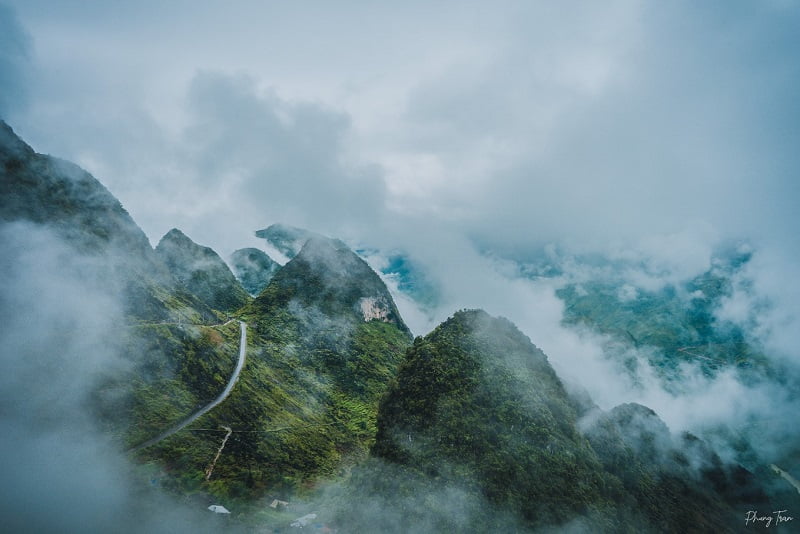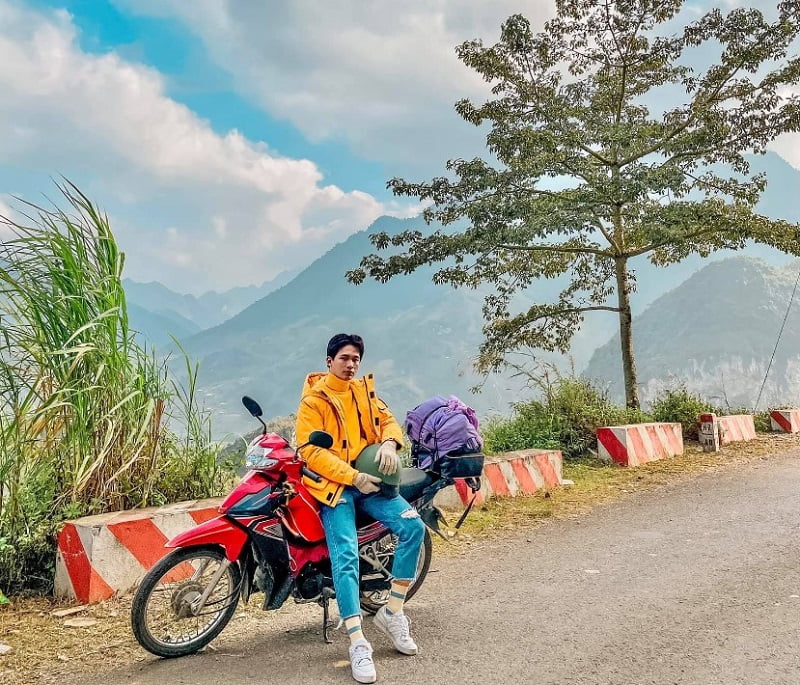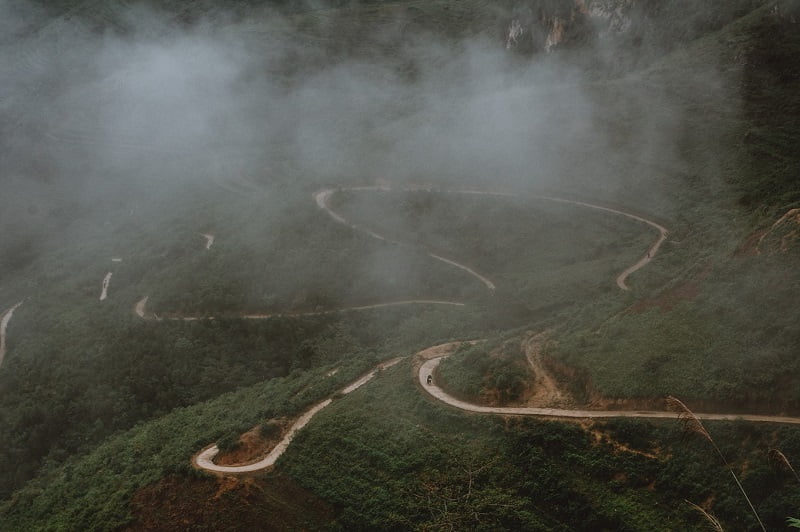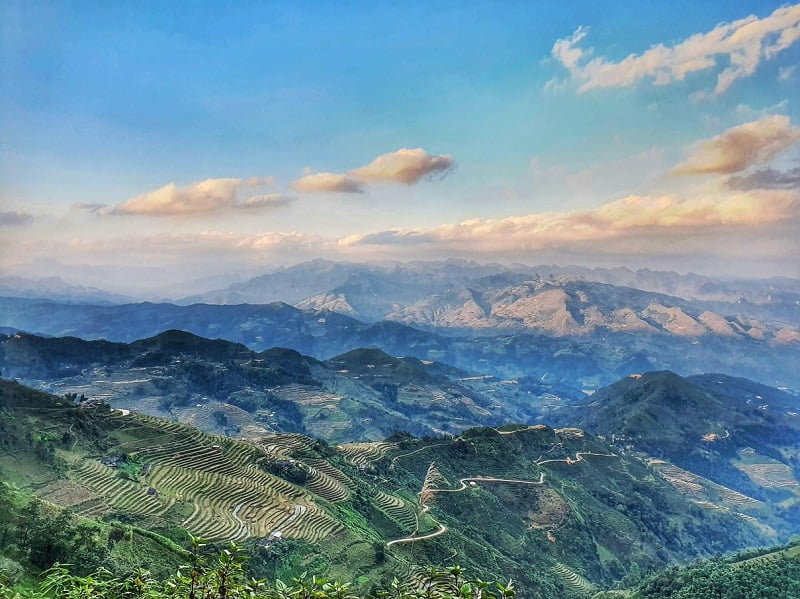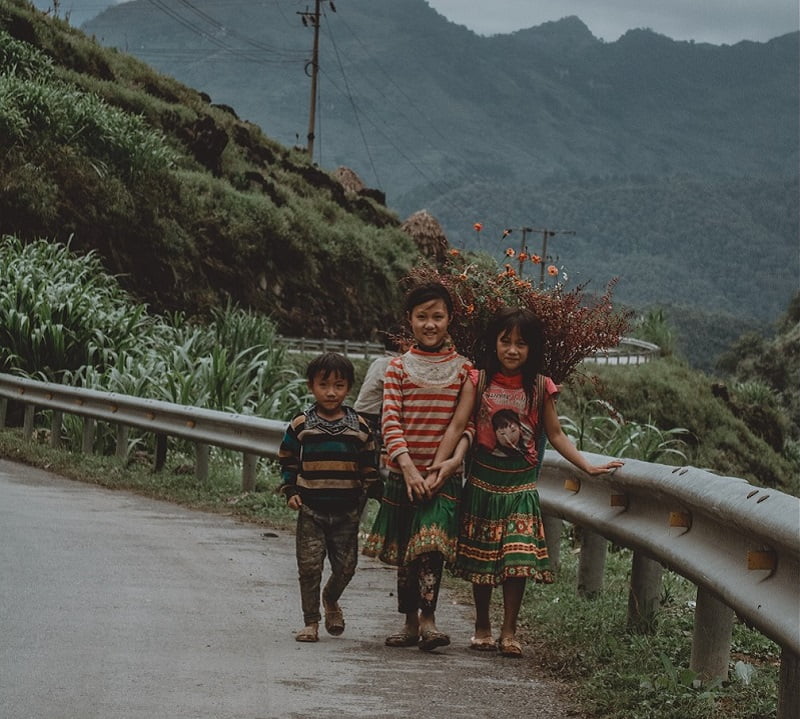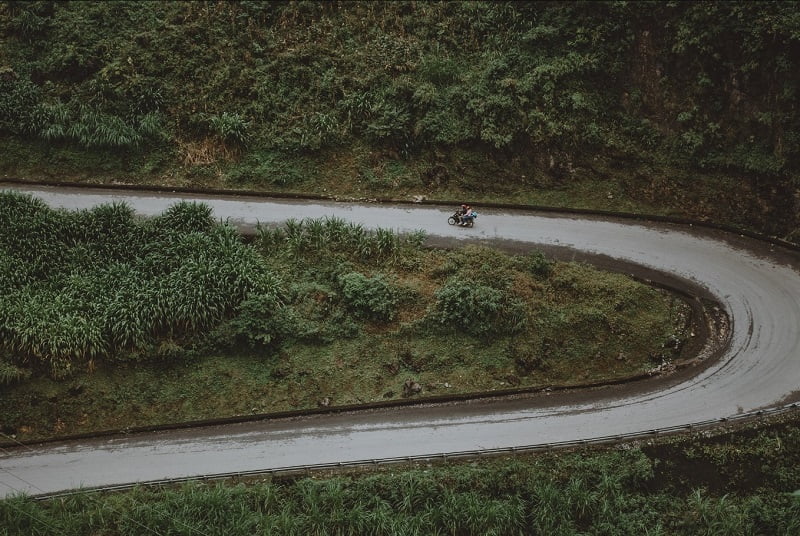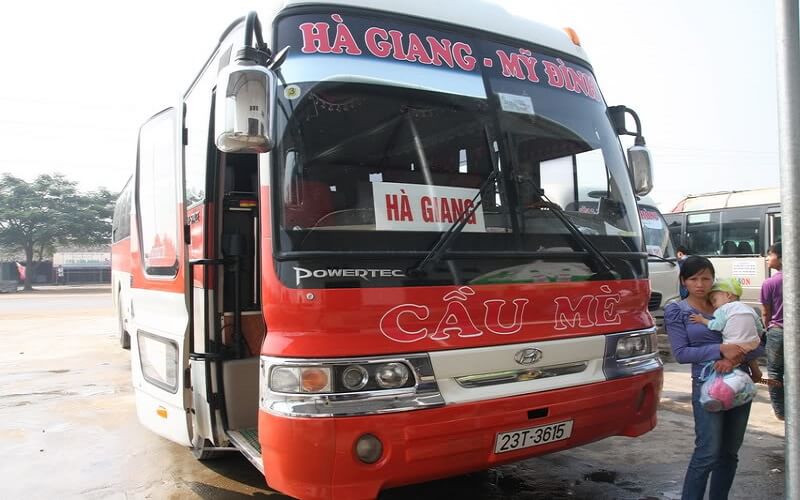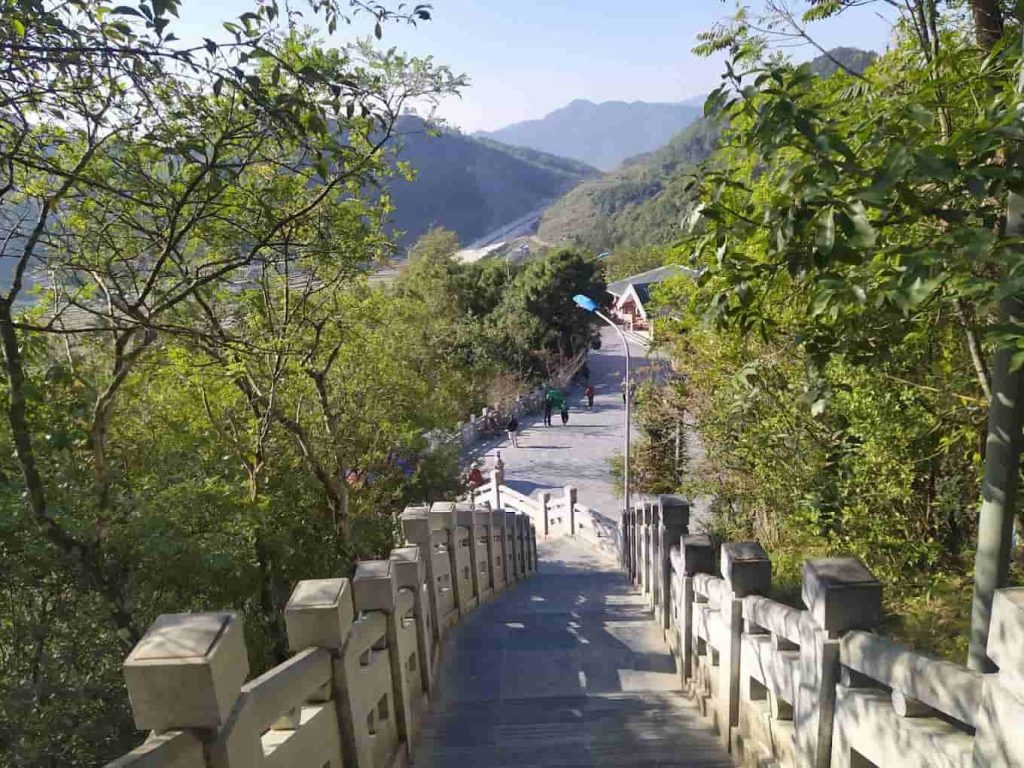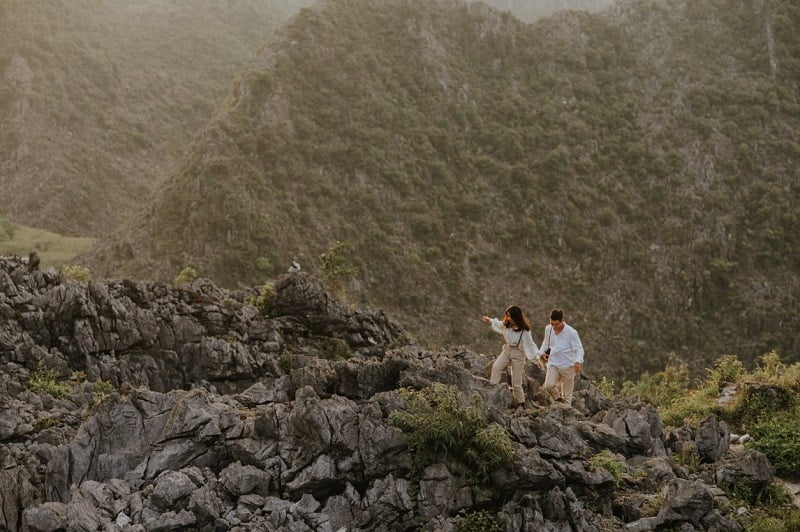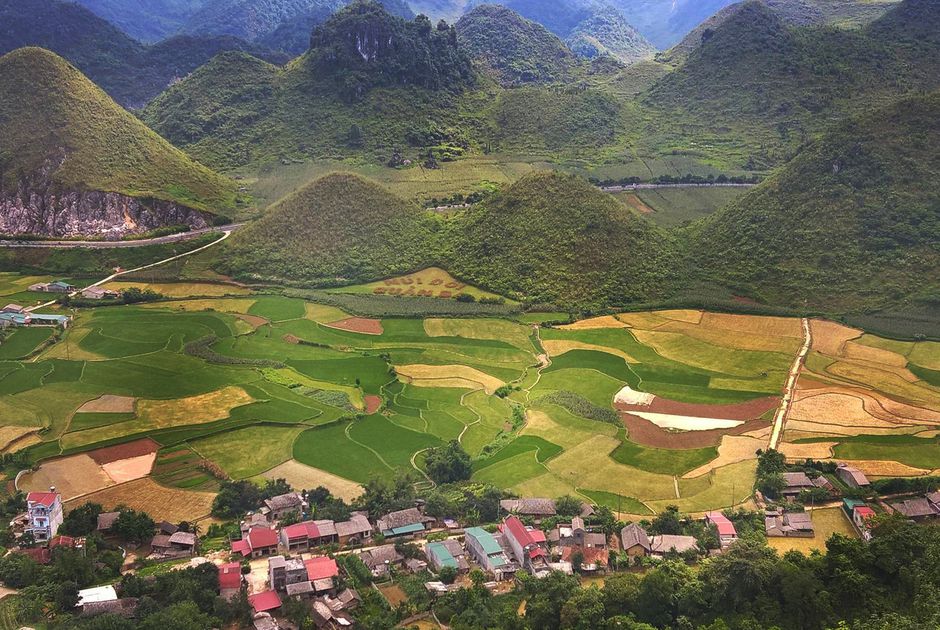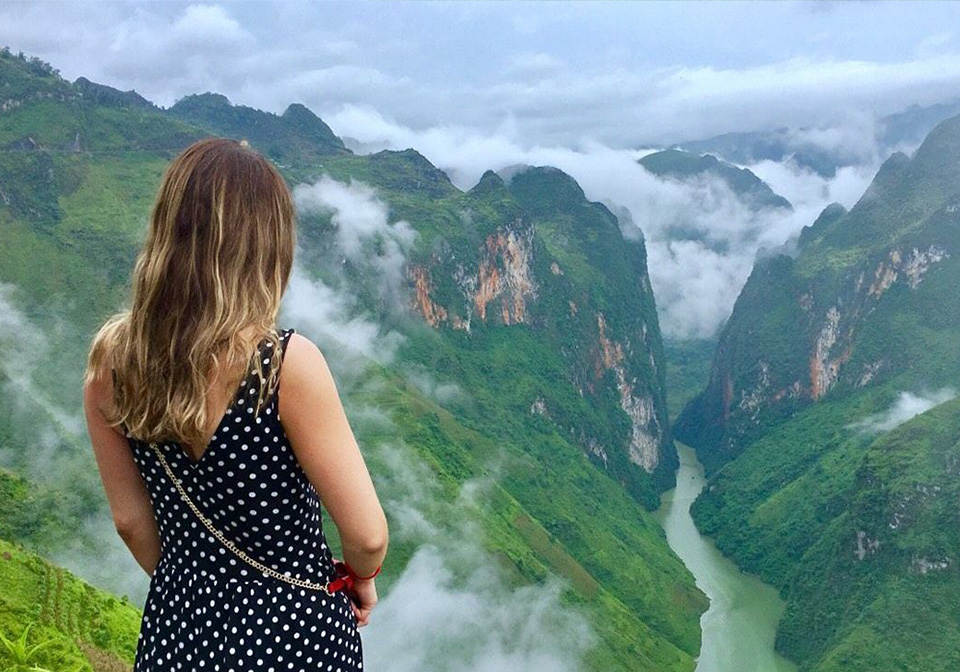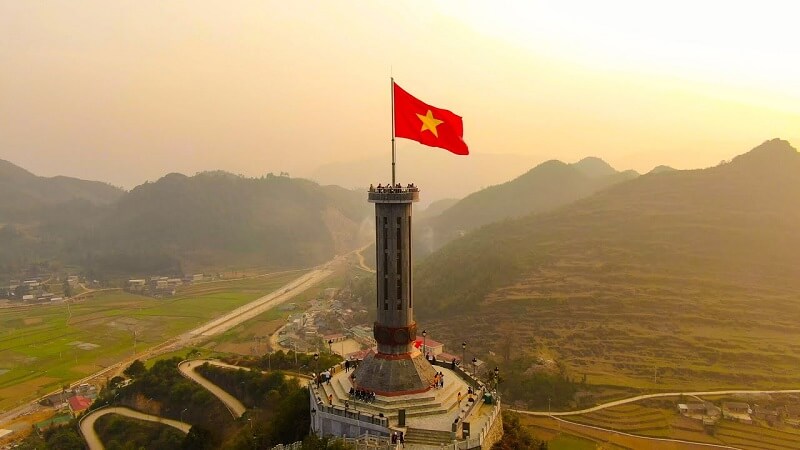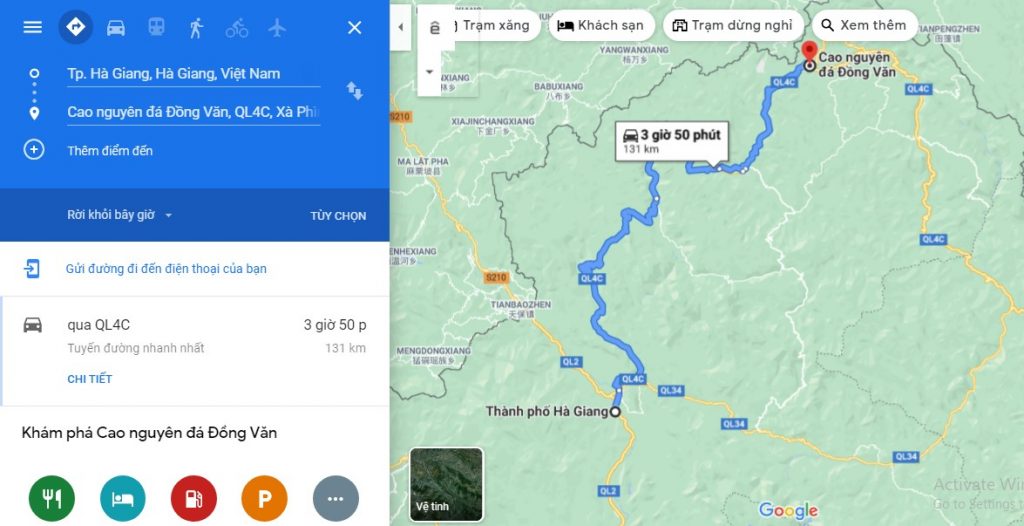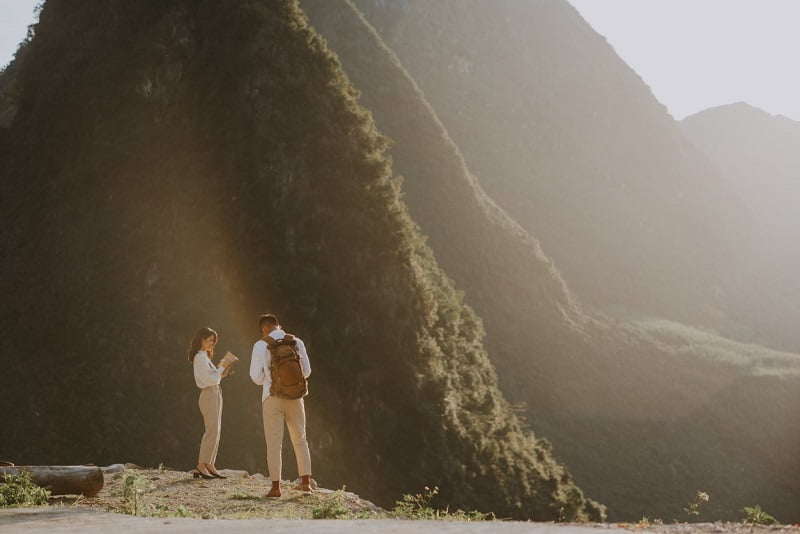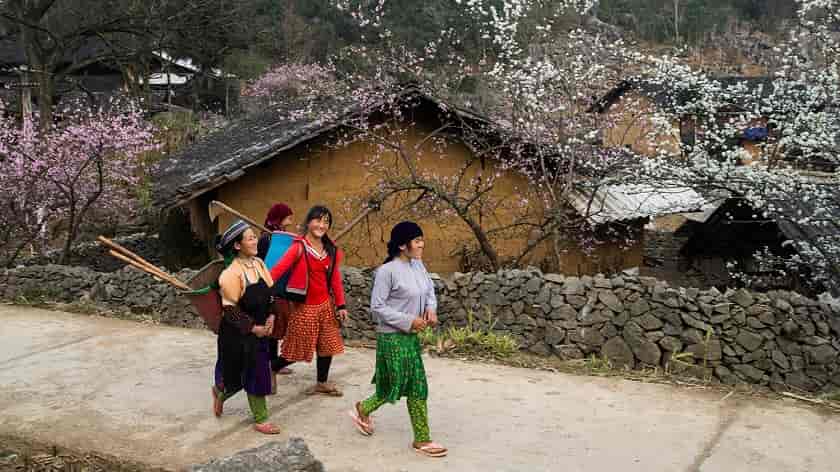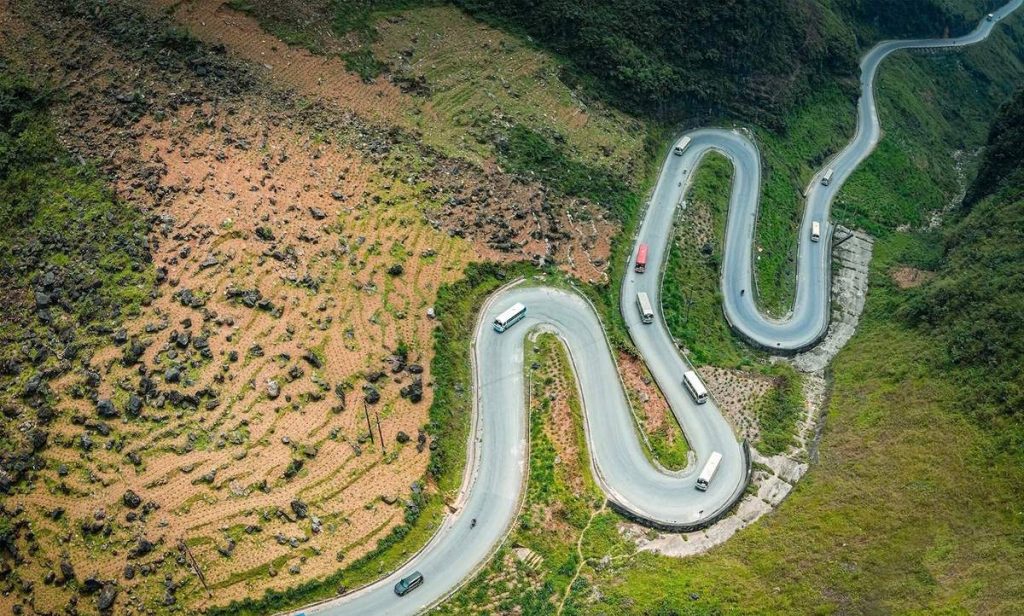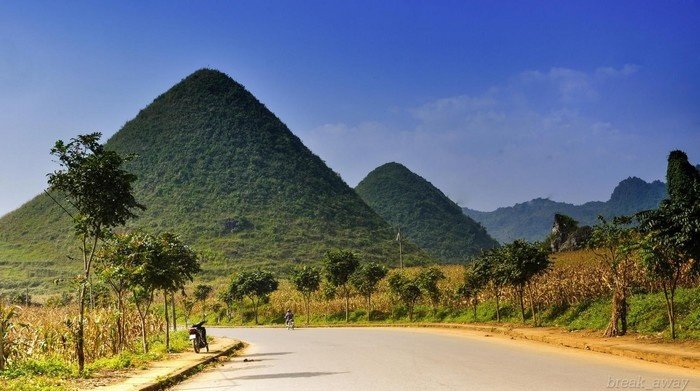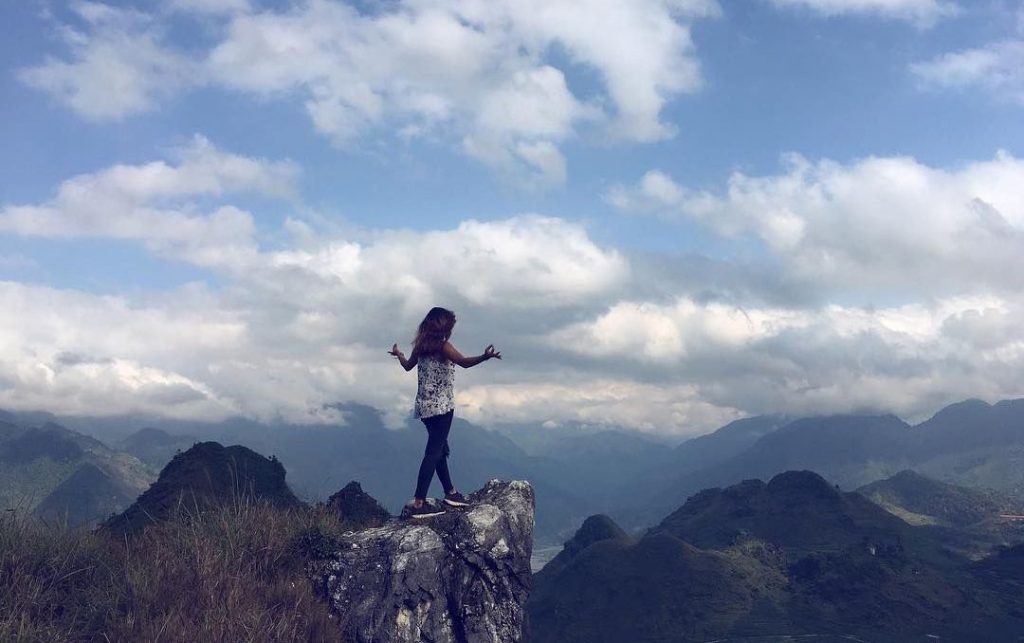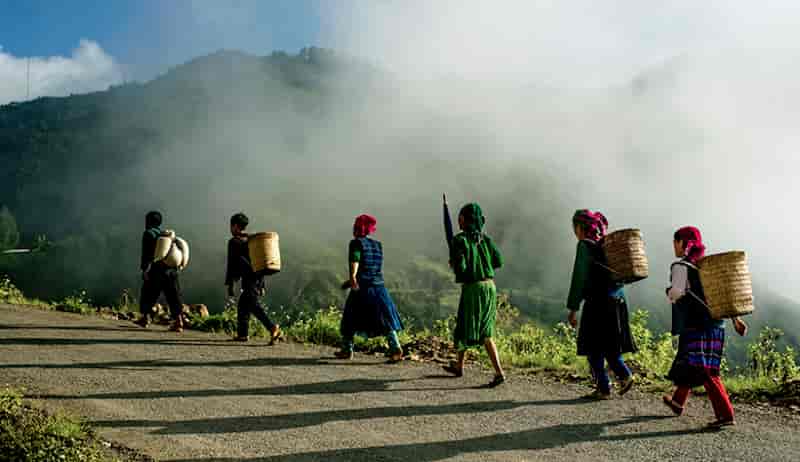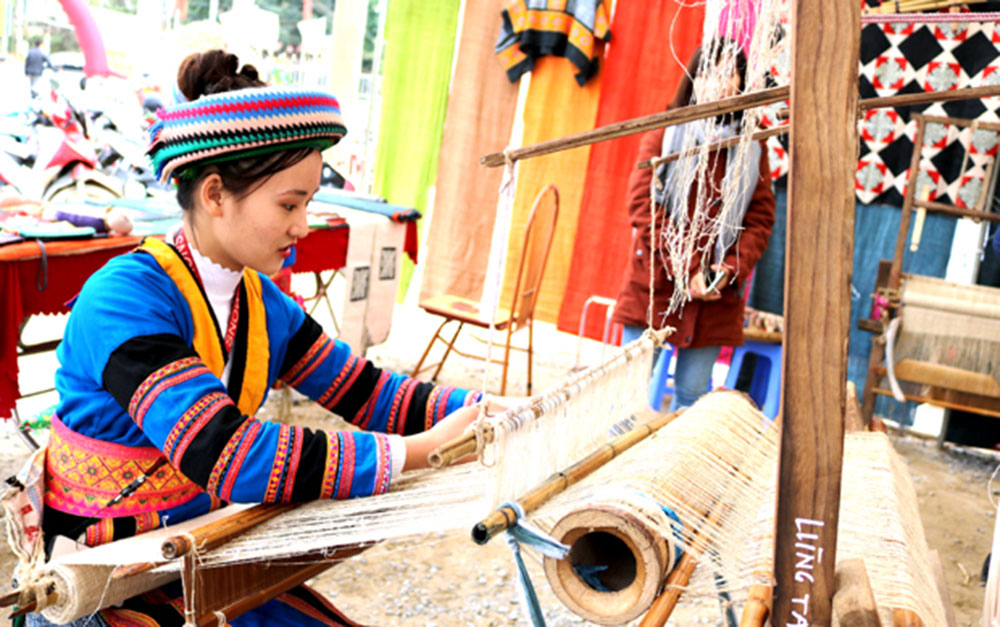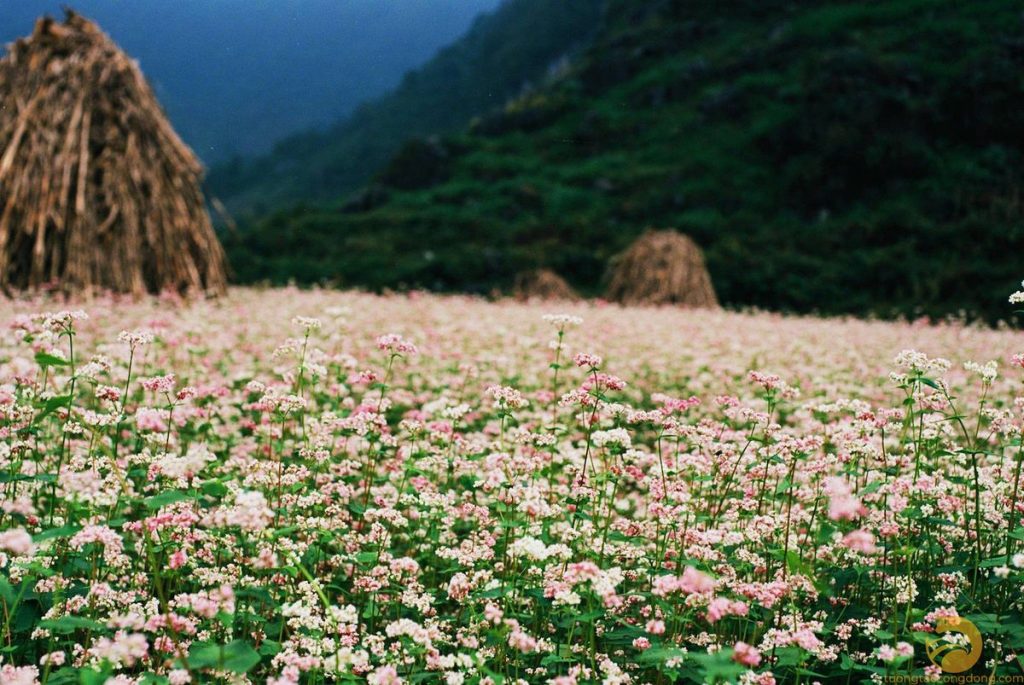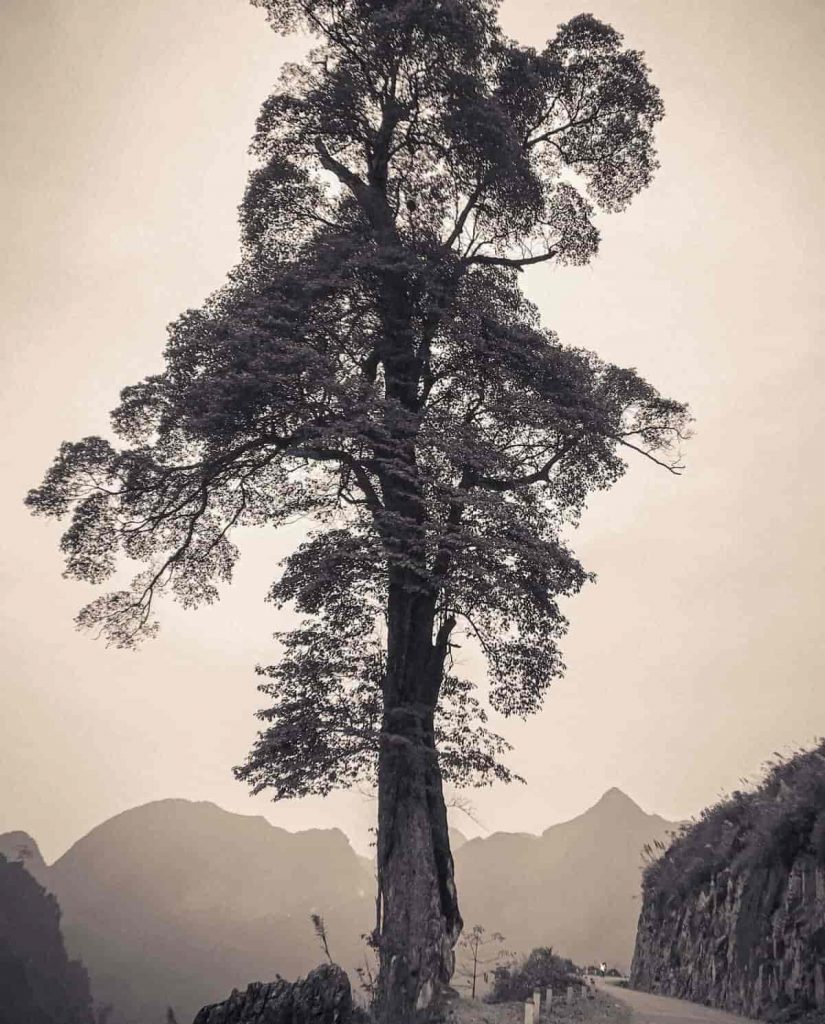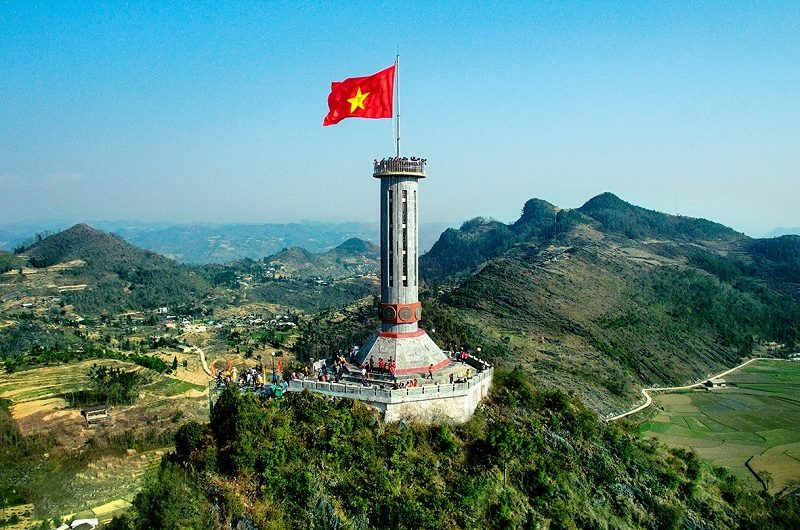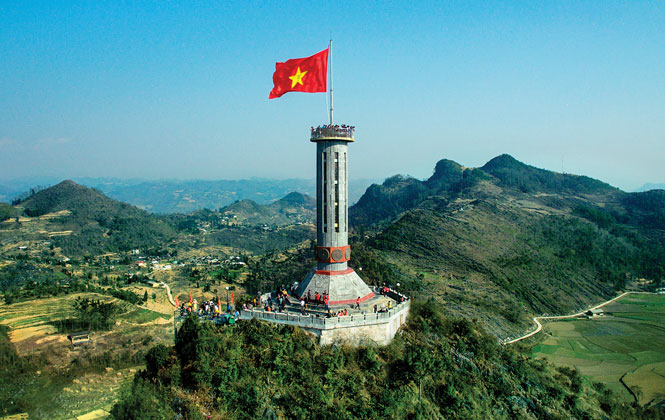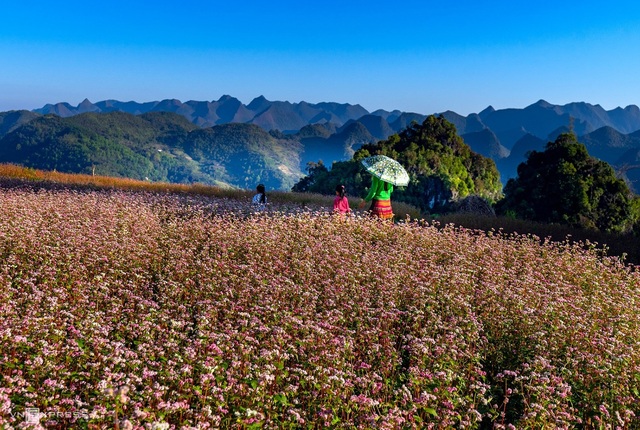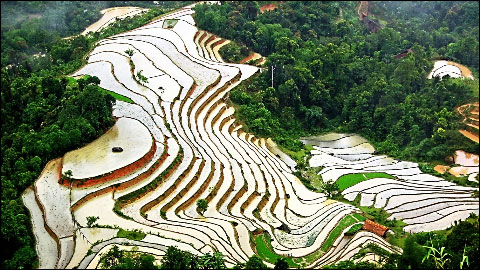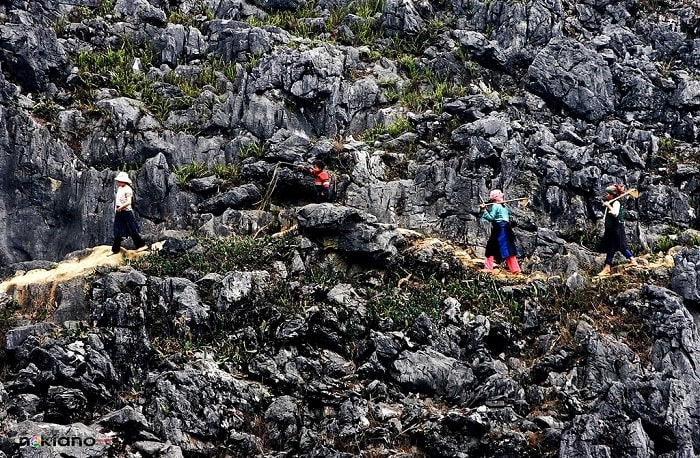Ha Giang is one of the northernmost regions of the homeland of Vietnam, and when travelers come here, they will be immersed in the stunning natural landscapes. If you are fortunate to have the opportunity to visit this frontier land of the homeland, please refer to the article about famous tourist destinations in Ha Giang, Vietnam below by Danang Private Car’s!
KM 0 Milestone
As soon as travelers set foot in the city of Ha Giang, they will encounter the image of kilometer marker 0. This is one of the landmarks where many tourists visiting Ha Giang stop for a check-in. This road connects the city with four highland districts and the four districts of the rocky plateau in Ha Giang.
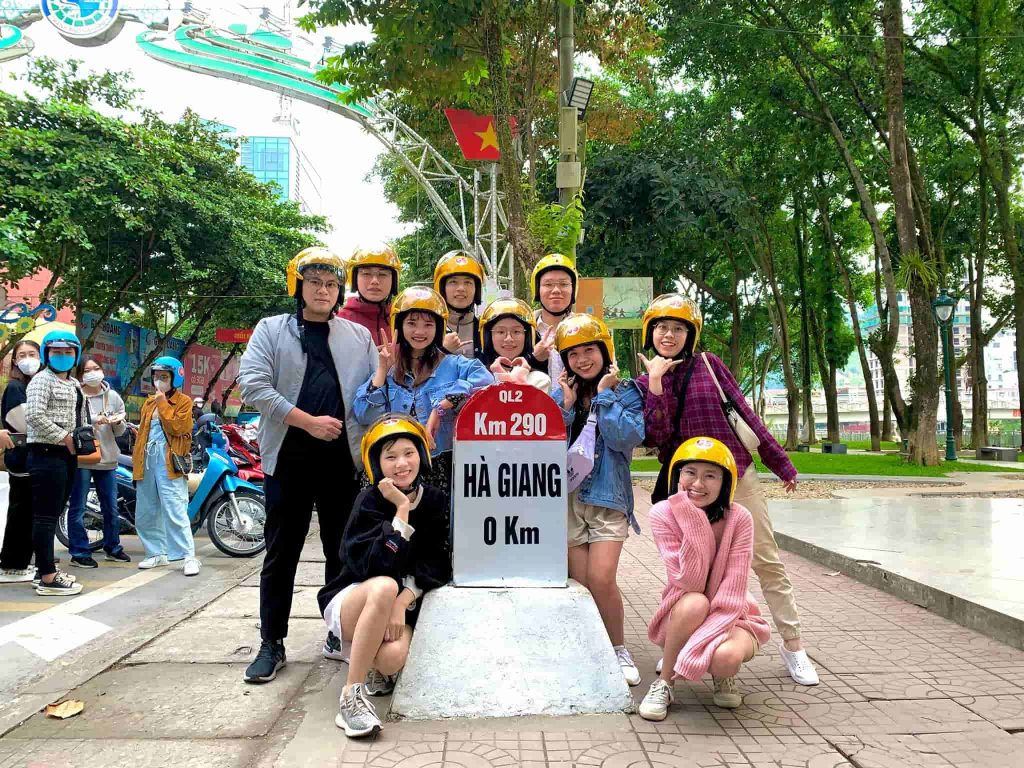
This is also one of the first places for you to start your journey to explore the Ha Giang rocky plateau.
- Address: Ha Giang City
Read more articles: Introduction in detail about Ha Giang tourism to have a comprehensive and detailed view of Ha Giang tourism
Quan Ba Twin Mountain
After checking in at the KM 0 tourist destination, to continue your sightseeing journey, you can head to the Quan Ba Twin Mountain. This is one of the tourist destinations that connects various districts in Ha Giang.

The twin mountains have a round and attractive shape, resembling the round breasts of fairies. They are situated amidst the rocky landscape, terraced rice fields, and rocky mountains.
Below the Quan Ba Twin Mountain, there is a picturesque view of terraced rice fields that create a fascinating scene for travelers.
- Address: Tam Son Town, Quan Ba, Ha Giang
Sung La Valley
Sung La Valley is renowned as one of the famous tourist destinations in Ha Giang, with its magnificent flower colors. It’s known as a beautiful flower amidst the rocky highlands, attracting travelers with its gentle and rustic beauty.
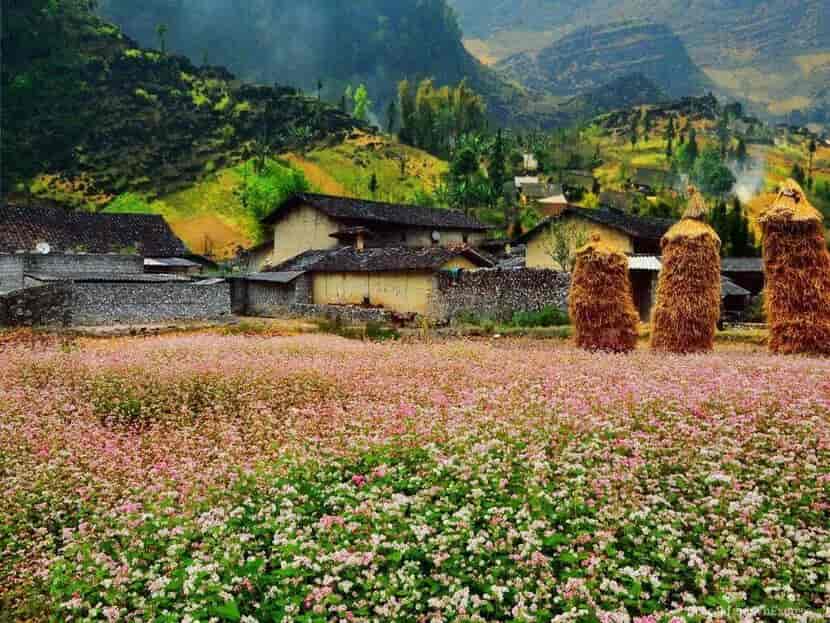
The traditional houses here still retain their beauty with tiled roofs and rustic charm. Looking down from the winding road, you’ll see a stunning natural painting with rocky cat-ear mountains and dark, ancient forests, as well as the hardworking locals cultivating their land.
This place promises to be a wonderful and interesting stop for travelers.
- Address: Sung La Valley, Dong Van, Ha Giang
Yen Minh Pine Forest
When talking about pine forests, we often think of Da Lat. However, in the Yen Minh region of Ha Giang, there is an equally attractive tourist destination, Yen Minh Pine Forest. After passing through the Quan Ba Twin Mountain area, you will arrive at the Yen Minh Pine Forest.
Here, the lush green pine trees stretch high into the mountains, creating a captivating landscape with rows of pine trees extending for kilometers across the hills.
Yen Minh is not just about the bamboo forest and pine forest; it also offers winding paths and solid, traditional houses that give Yen Minh a peaceful and warm charm. Yen Minh is a wonderful place to visit and immerse yourself in the beauty of the area.
- Address: National Highway 4C, Na Khe, Yen Minh, Ha Giang
Lung Cu Flag Tower
Lung Cu Flag Point is situated at an elevation of 2000 meters above sea level. It is a primary residence of the Lolo people. Standing at the Lung Cu Flag Tower, watching the flag fluttering in the wind, you can’t help but feel a sense of pride and love for your ethnic group and a deep affection for your homeland and country as a tourist. Standing at the Lung Cu Flag Tower and looking at the sunset and down to Dong Van Town makes this an appealing tourist destination for you.
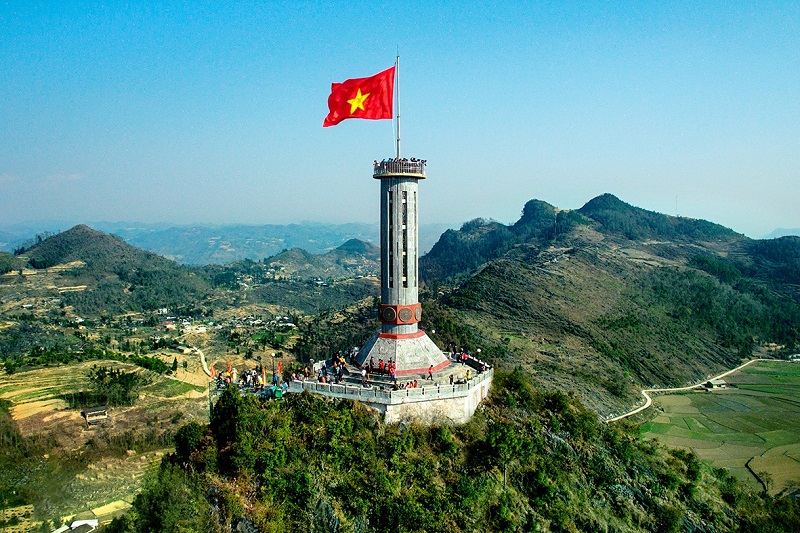
Upon visiting the Lung Cu Flag Tower, you’ll witness the magnificent scenery of the area, as well as the neighboring country, China. Almost everyone who comes to Ha Giang makes a point to visit this tourist destination to touch the northernmost point of Vietnam.
- Address: Lung Cu, Dong Van, Ha Giang
Dong Van Old Town
Dong Van Old Town is a gathering place for various ethnic groups, including the Tay, Hoa, Mong, Nung, and more, who have settled here. Stopping in the old town, tourists will feel the antique charm with a nostalgic atmosphere, along with distinctive characteristics bearing the mossy yellowed hue of time.
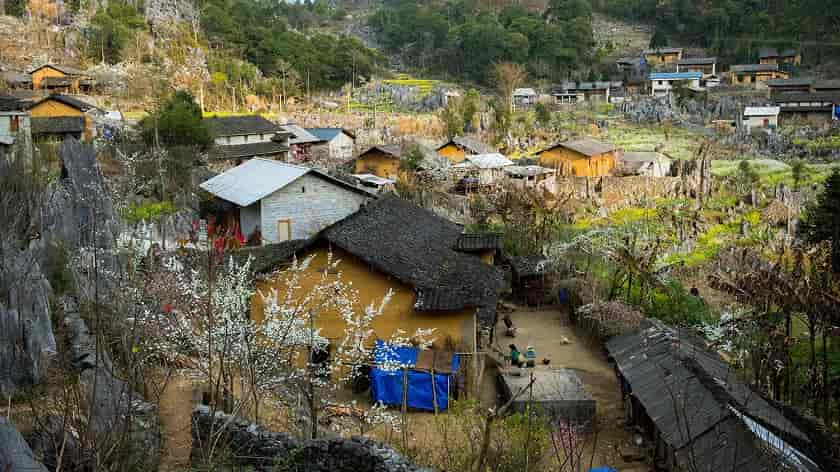
The best time to visit the old town is during the Sunday market, where you can immerse yourself in the daily life of the local people. Here, you have the opportunity to savor local cuisine and experience the cultural beauty of the area.
- Address: Dong Van, Ha Giang
Ma Pi Leng Pass
With its winding and treacherous road, the Ma Pi Leng Pass is considered one of the four great mountain passes in the northern mountainous region. It connects Dong Van and Meo Vac. This is one of the most sought-after tourist destinations for adventurous travelers.
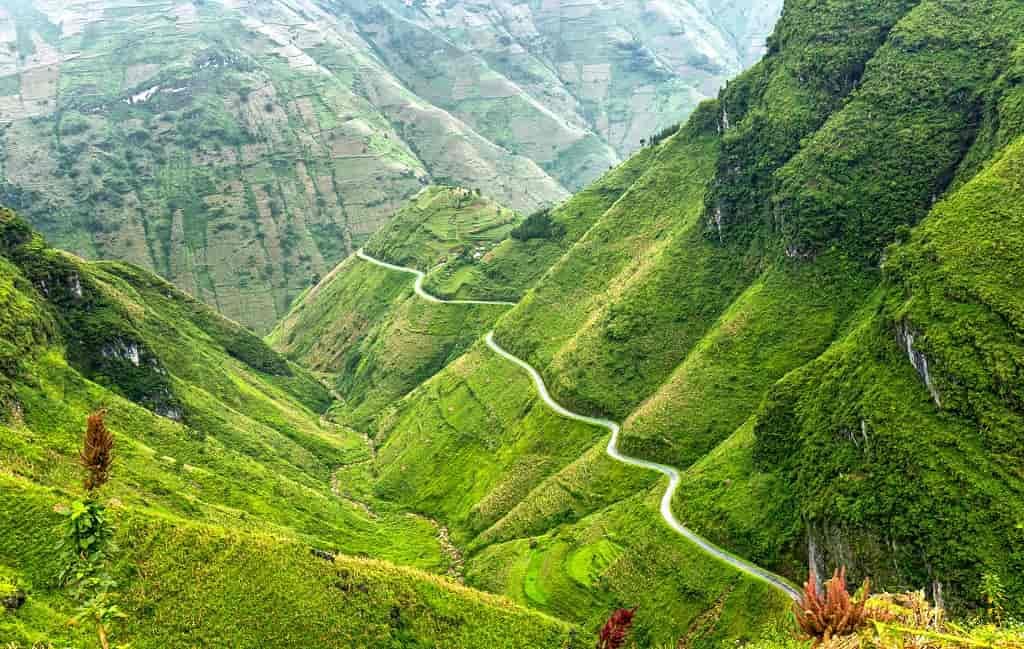
From here, you can easily admire the magnificent landscape, with the Nho Que River flowing in a mesmerizing shade of green, winding its way through the rugged mountains.
Ma Pi Leng Pass is a stop for those who love adventure and scenic routes. If you plan to conquer this pass, be cautious, as it can be quite challenging. You need strong driving skills to tackle this pass.
- Address: National Highway 4C, Meo Vac District, Ha Giang
Hoang Su Phi
Hoang Su Phi is one of the fantastic tourist destinations for travelers to visit in Ha Giang. The region is famous for its terraced rice fields, particularly during September and October.
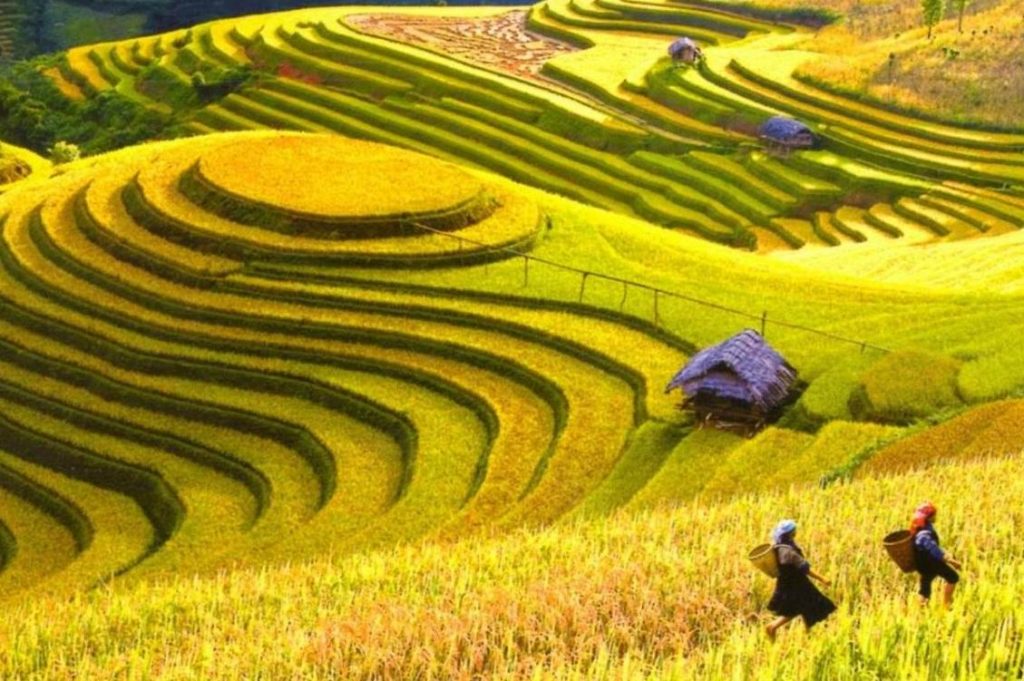
Each season in Ha Giang offers different views of Hoang Su Phi. Especially in September, it’s the time when most tourists flock here to capture the most beautiful photos of the terraced fields.
- Address: Hoang Su Phi District, Ha Giang
Tu San Alley
When you visit Ha Giang, don’t miss conquering the Tu San Alley, with its cliffs nearly 800 meters in depth and a length of nearly 1.7 kilometers. Tu San is one of the famous tourist spots in Ha Giang, and it’s a must-visit.
Traveling by boat on the Nho Que River to reach this location, you’ll experience the grandeur and awe-inspiring beauty of the scenery. The towering rock formations and the winding blue river create an unforgettable scene when you stop in Ha Giang.
- Address: Giang Chu Phin Commune, Meo Vac District, Ha Giang
Vuong Family Palace
Vuong Family Palace is renowned as the palace of the H’mong King Palace, built nearly a century ago with unique and intriguing architectural features. The mansion remains mysterious and hidden among the rugged valleys, making it a worthwhile visit.
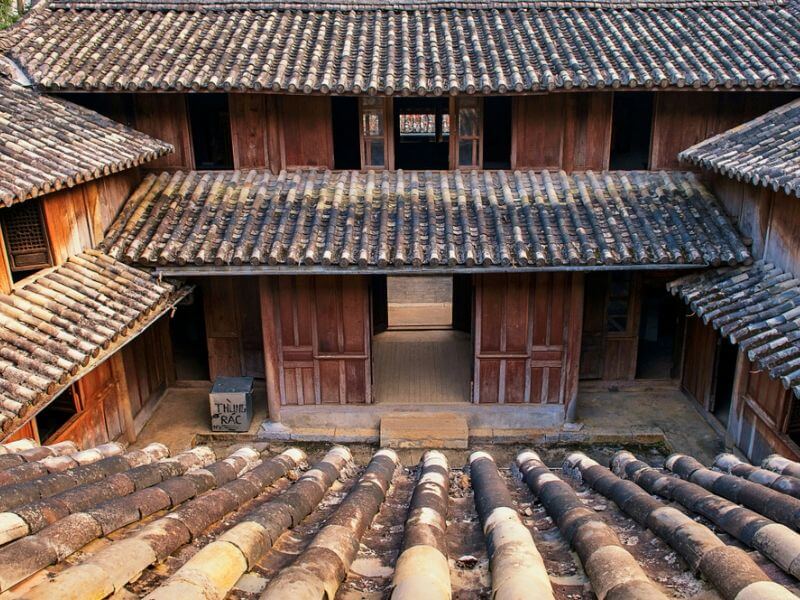
When you visit, you can wear traditional costumes of the local ethnic people. This will allow you to take beautiful photos that truly capture the spirit of the northern mountainous region.
Address: Phin Village, Dong Van, Ha Giang
Pao’s House
Pao’s House is the setting of the popular Vietnamese series Pao’s Story, which has garnered significant attention and viewership. This house exemplifies the authentic simplicity of the H’Mong people.
Visiting Pao’s House, you’ll have the opportunity to capture beautiful photos, feeling as if you’re immersed in the storyline. Each house and scenery represented in the TV series can be seen here, and it’s a truly captivating experience. This is promised to be a beautiful stop when you explore Ha Giang.
- Address: Sung La Commune, Dong Van, Ha Giang
Pho Bang, Yen Minh
Pho Bang features unique ancient houses and terraced rice fields on both sides of the road to Pho Bang. In November, tourists can admire the beautiful buckwheat flowers blooming along the road, creating stunning scenes for visitors.
Bac Sum Slope
Located beneath the twin mountains, Bac Sum Slope is winding and challenging, resembling a snake. This is a place that many professional adventure enthusiasts visit when coming to Ha Giang. Each curve presents a challenge that thrill-seekers must conquer. The higher you climb, the more enchanted you become by the beauty of this slope.
- Address: National Highway 4C, Minh Tan Commune, Vi Xuyen District, Ha Giang
Lung Khuy Cave
Lung Khuy Cave is the most beautiful cave in the Ha Giang mountainous region. Step by step, as you enter the cave, you will discover the beauty of the stunning and impressive cave formations. The limestone formations appear in a variety of unique and rich colors, creating a fascinating and surreal beauty. The diverse and intricate shapes of the limestone formations offer a magnificent spectacle for travelers.
- Address: Lung Khuy Village, Quan Ba Commune, Quan Ba District, Ha Giang
Na Luong Cave
Na Luong Cave is one of the widest and deepest caves in the Ha Giang region. Inside the cave, there are numerous interconnected chambers with many glittering stalactites.
The cave’s interior is spacious with multiple connected chambers, adorned with layers of stalactites in various shapes and forms.
- Address: Yen Minh District and Sủng Trái Commune, Dong Van District, Ha Giang Province
Swallow Cave
This is the dwelling place of thousands of small swallows. To reach this location, tourists have to traverse different challenging paths, passing through the Quan Ba Heaven’s Gate area and through dense pine forests.
Swallow Cave allows you to witness the wonders of this place, and you’ll surely find it incredibly worthwhile to see these sights with your own eyes.
- Address: Yen Minh District, Ha Giang
Sam Pun Border Crossing
This is a relatively lesser-known place among tourists. Here, you have the opportunity to enjoy the scenery and the serenity of both nature and everyday life.
Visitors can witness the daily life of the local people and experience the peaceful environment. Additionally, you can check in at the border marker 450, offering a unique experience with neighboring China.
- Address: Xin Cai and Thuong Phung Communes, Meo Vac District, Ha Giang Province, Vietnam.
Noong Lake
Noong Lake covers an area of up to 80 hectares. When visiting in May and June or August and September during the flooding season, tourists can admire the most beautiful scenery of Ha Giang.
The lush vegetation surrounding the lake, along with the beautiful landscape, creates a refreshing atmosphere. The pristine nature makes anyone who sets foot here feel captivated and awe-struck.
- Address: Phu Linh Commune, Vị Xuyên District, Ha Giang.
Thi Waterfall
Thi Waterfall is a natural geological formation that has been shaped over millions of years. It is an enchanting place for visitors to stop and enjoy.
Phuong Thien Cave
This is a very interesting stop for tourists. Visiting here, you can take in the natural beauty of this land. The cave is located in Vi Xuyen District, about 7 km from the center of Ha Giang city. It’s one of the tourist destinations where you can witness stunning views of mountains and sky. The natural setting is serene, and you’ll also feel the tranquility of everyday life.
- Address: Vi Xuyen District, approximately 7 km from the center of Ha Giang city.
Buckwheat Flower Fields
Ha Giang is known for its vast buckwheat flower fields. However, few tourists know where to find the most abundant buckwheat flower fields. In the early days of October to December, travelers have the opportunity to visit Hà Giang along the small villages’ paths and admire the colorful buckwheat flowers.
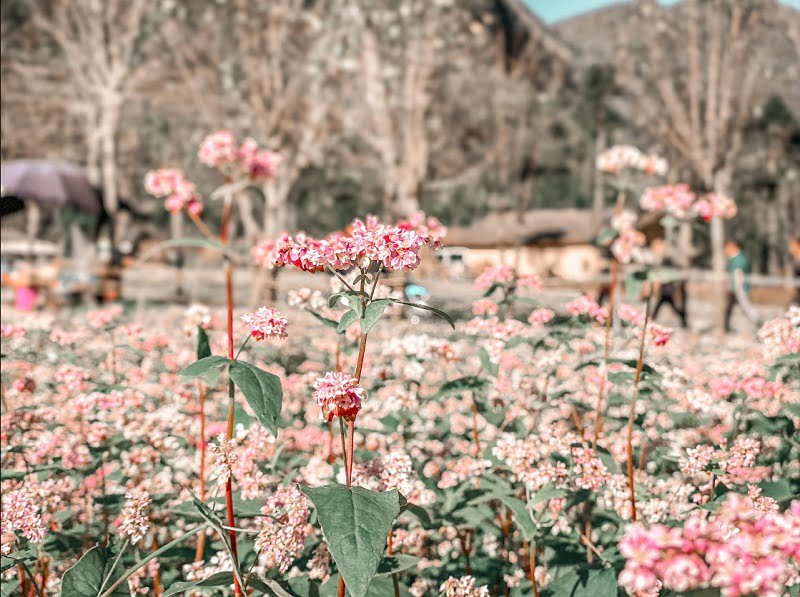
Sung Khanh Pagoda
This is known as a Nung ethnic village pagoda located on the Nung Mountain, near the Lo River, about 9 km from the center of Ha Giang. It’s a well-preserved ancient architectural structure with a beautiful location, nestled against the mountain and overlooking the Thich Bich River.
The pagoda has existed for centuries and holds many stone steles over 600 years old, which are classified as national treasures.
- Address: Lang Nung Village, Dao Duc Commune, Vi Xuyen District, Ha Giang.
Lung Tam Cultural Village
The traditional Lung Tam brocade weaving village has a long history, with most families engaged in this craft. This village is not only a source of income for families but also a place where the cultural traditions of the H’Mông people are preserved. The village’s woven products reflect the essence of Hà Giang’s people, and they have spread to various European countries.
These products embody the sophistication and artistic beauty of the people of Ha Giang.
Solitary Pine Tree
The solitary pine tree in Ha Giang is renowned as one of the most beautiful pine trees in Vietnam. It’s a picturesque location in Yên Minh District. Visitors flock here all year round to explore and take pictures. If you have the chance to visit Ha Giang, be sure to stop by this tourist destination!
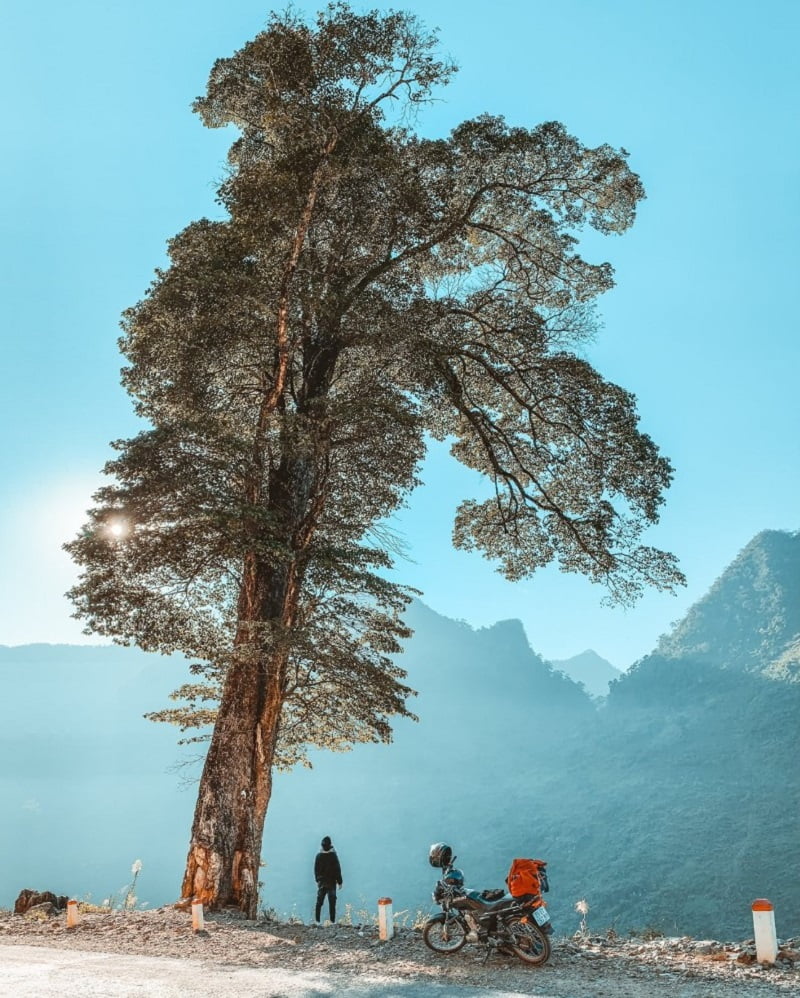
Khau Vai Love Market
Khau Vai Love Market is one of the most densely populated areas of H’Mong people. It is usually organized in the fourth month of the lunar calendar. Visitors to this market can witness the beauty of H’Mong young men and women and immerse themselves in the cultural performances of the locals’ daily life.

Below is the complete list of the top 25 famous tourist destinations in Ha Giang that you must visit. I hope this article has provided you with additional information about Ha Giang and the northernmost region of Vietnam. If you are planning to travel to Ha Giang but don’t know where to start, please contact DanangPrivateCar.com’s for the most detailed advice.


